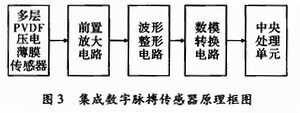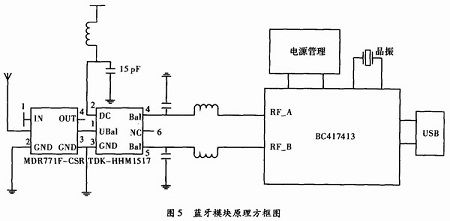With the rapid development of sensor technology, material technology and wireless communication technology, the combination of medical monitoring equipment and clothing can better meet the needs of people. This article refers to the address: http:// In this paper, a wearable multi-parameter monitoring intelligent clothing system is proposed, which integrates sensors, fabric cables and flexible circuit boards into clothing, realizing dynamic and collaborative monitoring of multiple physiological parameters in daily life and working environment. Signal detection, signal feature extraction, and use Bluetooth technology to complete data backup for further analysis, or use Bluetooth-enabled communication equipment to achieve remote medical services and other functions. 1 system hardware components The principle of the Bluetooth smart clothing system is shown in Figure 1. The system consists of a battery module, a sensor, a flexible circuit board, an electronic fabric, a central processing unit, and a Bluetooth module. The CPU adopts the ADμC7024 processor based on ARM7TDMI core of ADI. The ADμC7024 has excellent processing capability, integrates many on-chip peripheral devices and low power consumption of the chip, and is fully qualified for the current application of the system. The system uses the sensor to non-invasively collect various vital signs parameters of the human body, and the processor performs soft processing on the collected signals, and can calculate body temperature, heart rate, blood pressure and the like. And back up the information to the built-in Bluetooth mobile phone, computer and other devices through the Bluetooth module. The system is capable of emitting an alarm signal when the physical condition is abnormal. The system can also support telemedicine services by forwarding. 1.1 Monitoring sensor The sensor is responsible for measuring the collection of vital signs such as heart rate and body temperature. Considering the wearable features of the system, in terms of sensor selection, products with integrated, high sensitivity and high precision should be selected as much as possible, which can reduce the area of ​​the system circuit, facilitate wear, and improve the stability and reliability of the system. Sex. The blood pressure collection module uses the MPXV5050GP piezoelectric sensor produced by Freescal, and is placed inside the elbow joint of the middle sleeve of the sleeve, so that the pressure of the arterial blood to the blood vessel wall can be directly converted into an output electrical signal. The specific circuit is shown in FIG. 2 . The sensor uses an ion implantation process, and integrates a signal processing unit circuit such as an amplifier and a filter. The external device requires only a few components to operate. The amplified and shaped electrical signal is output at the output, so that the output of the sensor is directly connected to the ADμC7024's internal 12-bit ADC for analog-to-digital conversion. The blood pressure value is obtained by software processing. PVDF piezoelectric film has the characteristics of light weight, soft texture, good durability and large dynamic range of piezoelectric response. Multi-layer contact piezoelectric film sensor is used to measure heart rate, which can reduce interference signals. The heart rate acquisition module uses the HK-2000H integrated digital pulse sensor, which is placed on the left chest of the garment to measure heart rate. HK-2000H integrates PVDF piezoelectric film, high-sensitivity temperature compensation component, temperature sensing component, program-controlled amplifier circuit, signal conditioning circuit, filter circuit and A/D conversion circuit. Integration avoids the disadvantage of using a discrete component design circuit to occupy a large area. The schematic is shown in Figure 3. The HK-2000H integrated digital pulse sensor uses a USB port output for easy software processing of its output. The body temperature acquisition module uses Maxim's analog temperature sensor MAX6612 to detect body surface temperature. The MAX6612 is available in a 5-pin SC70 package with a maximum operating current of only 35μA. It features low power consumption, high accuracy, and small size. It is optimized for the ADC and is suitable for this system. The specific body temperature acquisition circuit is shown in Figure 4. The relationship between the output amplitude of the MAX6612 and the measured temperature satisfies the expression. The measured output electrical signal is analog-to-digital converted by a 12-bit successive approximation ADC on the ADμC7024 processor. The conversion result will be stored in the ADCDAT0 register. The ADC bit status register can be used to see if the ADC conversion is complete. At the end of the conversion, the lowest bit is set. The measured body surface temperature is obtained according to the above algorithm by reading the value in the register ADCDAT0 and then using software. 1.2 Flexible circuit board Considering the comfort of the clothing, it can not affect the processing of vital signs data. The motherboard is designed with a flexible circuit board. The circuit board is made of polyimide or polyester film, can withstand multiple bending, folding and winding, and has good heat dissipation performance. It can be easily combined with electronic fabric to distribute the sensor network throughout the body. It not only has less influence on the comfort of the clothing, but also facilitates the collection of various vital signs data. 1.3 Electronic fabric In order to facilitate the acquisition of sensor data under conditions that do not affect wearing comfort as much as possible, the system uses a method of braiding metal wires into a conventional fabric to manufacture electronic fabrics to achieve electrical connection between modules in the garment. This protects the metal wires, reduces wearer discomfort, and facilitates the transfer of data collected by the sensor to the processor for processing. 1.4 Bluetooth module The system uses a Bluetooth module to implement data exchange with an external device embedded with Bluetooth. In order to reduce system size, reduce system quality and reduce power consumption, the Bluetooth module adopts Class-2 design scheme, USB output, transmission distance of 10 m, and supports Bluetooth 2.0 version protocol to meet system requirements. The Bluetooth chip uses CSR's BC417413. The chip integrates 8 MB of flash memory. It mainly stores the software of the baseband, link management layer and host control interface, and also includes some APIs for configuring the chip. The front-end RF bandpass filter uses MDR771F-CSR-T. Barron uses TDK's HHM-1517 to complete the conversion between the system's differential RF signal and the antenna input and output signals. The schematic diagram of the specific design scheme is shown in Figure 5. 1.5 External expansion function This system supports the expansion of system functions. For the actual needs of patients with diabetes and hypertension, modules such as blood glucose and blood oxygen can be installed to perform non-invasive continuous monitoring of blood sugar and blood oxygen. Allows the wearer to take measurements at any time, making it easy to operate. 2 software design The system software includes a wearable monitor section and an outreach component section. 2.1 Wearable Monitor Software The wearable monitor can work in two modes: one is the heart rate acquisition mode, and the other is the full acquisition mode. The block diagram of the program is shown in Figure 6. When working in the heart rate acquisition mode, the wearable monitor monitors the wearer's heart rate in real time, and when the heart rate is less than a certain critical point, an alarm signal is sent to remind the wearer to pay attention, and the heart rate data is sent to the external device via Bluetooth. This mode reduces power consumption and extends battery life. After receiving the command sent by the external device, the wearable monitor works in the full collection mode. At this time, all vital sign parameter data supported by the wearable detector is collected and transmitted to the external device through the Bluetooth module. 2.2 Outreach device software The outflow device software flow chart is shown in Figure 7. The external device can remotely control the wearable monitor to work in the whole collection mode, and the physiological indicators collected by the wearable monitor are saved on the terminal display screen in real time, which is convenient for later viewing. If necessary, the collected data can be sent to a remote doctor via a wireless network and an Internet network for remote monitoring. When the user's key physiological index is less than or greater than a certain critical point, the outreach device can send the collected data and GPS information to the preset emergency contact by SMS and dial the number to ensure that the emergency contact can The first time to know the user's physical condition, timely rescue measures to protect the wearer's life safety, suitable for people with sudden heart disease. 3 Summary and outlook A smart clothing system for life monitoring was proposed and designed, and the appropriate working mode can be selected according to the needs of users. At the same time, the system uses the Bluetooth technology to network the external devices such as the human body, the smart phone and the computer, and can back up the collected vital signs data, and facilitate the development of the telemedicine service.
The PufangTech UHF wireless modem operates in 400MHz to 470MHz frequency band and has a range of 1 to 10Km through buildings and up to 30Km line of sight. It transmits and receives half duplex serial data at interface baud rates of 1200bps to 115200bps with narrow band digital frequency modulation.
The configuration menu of the wireless modem can be accessed by a Windows based program running on PC. The design has been optimized for low current consumption and reliability, making PufangTech`s UHF wireless modems suitable for operation on remote sites.
Applications of PufangTech`s UHF wireless modem include SCADA, telemetry, security, command & control, data logging, remote switching or other similar applications where serial data needs to be transmitted and cable is not a practical solution.
UHF Wireless Modem,VHF Wireless Audio Modem,UHF Wireless Data Radio Modem,UHF HF Wireless Modem Shenzhen PuFang Technology Co., Ltd. , https://www.hytelus.com



![]()



February 12, 2020